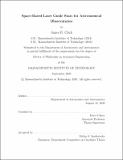| dc.contributor.advisor | Kerri Cahoy. | en_US |
| dc.contributor.author | Clark, James R.,Ph. D.Massachusetts Institute of Technology. | en_US |
| dc.contributor.other | Massachusetts Institute of Technology. Department of Aeronautics and Astronautics. | en_US |
| dc.date.accessioned | 2021-01-06T18:31:22Z | |
| dc.date.available | 2021-01-06T18:31:22Z | |
| dc.date.copyright | 2020 | en_US |
| dc.date.issued | 2020 | en_US |
| dc.identifier.uri | https://hdl.handle.net/1721.1/129146 | |
| dc.description | Thesis: Ph. D., Massachusetts Institute of Technology, Department of Aeronautics and Astronautics, September, 2020 | en_US |
| dc.description | Cataloged from student-submitted PDF of thesis. | en_US |
| dc.description | Includes bibliographical references (pages 215-221). | en_US |
| dc.description.abstract | The Laser Guide Star (LGS) concept is proposed to enable reductions in cost of next-generation space telescopes, by providing reference targets (as bright as apparent magnitude -7) to enable wavefront stability and control (WFSC) to compensate for high-rate motions of mirror segments. This will relax the requirements on the stability of the telescope and flow down to metrology, construction, and control. In this work, we present the detailed design of an LGS small satellite (and constellation of LGSs) that would fly in formation with a large space observatory that uses adaptive optics (AO) for wavefront sensing and control, or orbit around the Earth to support ground-based telescopes. We find that an LGS small satellite using the 12U CubeSat standard can accommodate a propulsion system sufficient to enable the LGS satellite to formation fly near the targets in the telescope boresight and to meet exoplanet direct imaging mission requirements on number of targets and duration. | en_US |
| dc.description.abstract | We simulate the formation flight for an LGS/telescope system at L2 to assess the precision required to enable the wavefront sensing and control during observation, and find that commercial off-the-shelf attitude control hardware can easily satisfy the pointing needs (error < 14°) and that the telescope needs to update the LGS no more than once every five minutes. We compare and recommend commercial off-the-shelf (COTS) propulsion and attitude determination and control systems (ADCS) for controlling the LGS spacecraft. We develop a constellation design tool for assessing the number of LGS spacecraft required to support a desired rate and quantity of observations at L2, and for trading that quantity against the parameters of the LGS spacecraft and the telescope(s) they support. We present a design reference mission (DRM) for deploying up to 19 LGS spacecraft to L2 to assist the Large Ultraviolet Optical Infrared Surveyor (LUVOIR). | en_US |
| dc.description.abstract | The L2 LGS DRM covers 259 exoplanet target systems with 5 or more revisits to each system over a 5-year mission. We also identify a series of technology demonstration missions for deploying an LGS satellite to geostationary orbit and other Earth orbits for use with 6.5+ meter ground telescopes with AO to observe Wolf 1061, 40 Eridani, and other near-equatorial targets. | en_US |
| dc.description.statementofresponsibility | by James R. Clark. | en_US |
| dc.format.extent | 221 pages | en_US |
| dc.language.iso | eng | en_US |
| dc.publisher | Massachusetts Institute of Technology | en_US |
| dc.rights | MIT theses may be protected by copyright. Please reuse MIT thesis content according to the MIT Libraries Permissions Policy, which is available through the URL provided. | en_US |
| dc.rights.uri | http://dspace.mit.edu/handle/1721.1/7582 | en_US |
| dc.subject | Aeronautics and Astronautics. | en_US |
| dc.title | Space-based laser guide stars for astronomical observatories | en_US |
| dc.type | Thesis | en_US |
| dc.description.degree | Ph. D. | en_US |
| dc.contributor.department | Massachusetts Institute of Technology. Department of Aeronautics and Astronautics | en_US |
| dc.identifier.oclc | 1227276699 | en_US |
| dc.description.collection | Ph.D. Massachusetts Institute of Technology, Department of Aeronautics and Astronautics | en_US |
| dspace.imported | 2021-01-06T18:31:21Z | en_US |
| mit.thesis.degree | Doctoral | en_US |
| mit.thesis.department | Aero | en_US |
